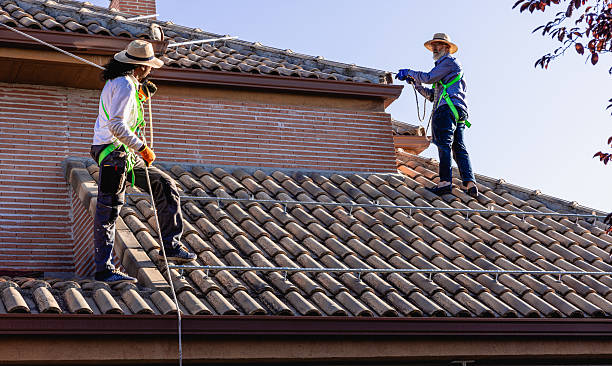As we progress through the 21st century, the importance of health and safety in all aspects of construction and maintenance cannot be overstated. In particular, rooftop safety remains a critical area of focus for industrial and commercial properties. Industry specialists are increasingly stressing the implementation of roof safe solutions to protect workers and mitigate the risks associated with working at heights. By 2025, it is expected that such measures will be not only recommended but mandated through more stringent regulations and standards.
The Imperative of Roof Safety
In light of the numerous accidents that can occur during rooftop operations, the integration of roof safe solutions is a discourse that is gaining momentum. The hazards are numerous, ranging from falls, trips, and slips to structural collapses and equipment failure. With this in mind, experts are urging facility managers, construction companies, and safety officers to prioritise these solutions to ensure the wellbeing of personnel and the seamless progress of rooftop projects.
Comprehensive Risk Assessment
The first step in addressing roof safety is to perform a comprehensive risk assessment. This analysis evaluates all potential dangers and the likelihood of their occurrence. By 2025, the expectation is that digital advancements will make these assessments more precise, accounting for variables such as weather conditions, material durability, and the health and fitness levels of workers. A thorough assessment is necessary before installing any safety measures on a roof.
The Evolution of Roof Safe Solutions
Technology and innovation continue to shape how roof safety is perceived and implemented. From guardrails and access ladders to fall arrest systems and anchor points, the industry is evolving with an increasing number of products designed to ensure secure and reliable roof access. The future of these rooftop solutions sees a synergy between structural integrity, ease of installation, and user-friendliness, to ensure comprehensive protection without compromising on efficiency.
Regulatory Compliance
In 2025, experts predict that regulatory bodies will place even greater emphasis on adherence to rooftop safety measures. This is not merely a question of mitigating risks but also of ensuring legal compliance to prevent liability issues. Companies will need to stay informed about local and national guidelines to ensure their roof safe solutions meet the requisite standards. It is anticipated that regulations will demand regular reviews and updates of safety equipment, with non-compliance resulting in severe penalties.
Installation and Maintenance of Safe Solutions
It is not enough to simply purchase and install safety systems; maintenance is paramount to ensure ongoing protection. By 2025, the expectation is that smart technologies will alert property owners to the degradation or malfunctioning of roof safety devices, prompting immediate action. Specialists in roof safety anchor installers will be essential partners in ensuring the efficacy of these solutions over time, offering professional installation and inspection services.
Training and Awareness
A part of implementing roof safe solutions is cultivating a culture of safety among employees. Ongoing training sessions will be necessary to ensure that all workers are familiar with the latest safety protocols and equipment use. With a projection towards increased virtual reality training modules by 2025, workers will have the opportunity to experience simulated high-risk scenarios without exposure to actual danger, leading to better preparedness and response in real-world situations.
Technological Integration
The future points towards a more technologically integrated approach to roof safety. Wearable tech, such as smart harnesses that can detect a fall and deploy additional safety measures, are just some of the innovative developments we expect to see by 2025. Additionally, drone technology could be employed for roof inspections, reducing the need for human workers to engage in risky inspections.
The Financial Aspect
Investing in roof safe solutions is an investment in sustainability and long-term profitability. By 2025, the economic incentive to implement these systems will be clearer as the industry recognises the cost savings associated with reducing workplace accidents. Insurers may offer lower premiums for properties that demonstrate a commitment to roof safety, thereby encouraging business owners to adopt the necessary measures proactively.
Environmental Considerations
Sustainability has become a prime consideration in construction and maintenance practices. Roof safe solutions of the future will not only need to protect workers but must also be environmentally friendly. Materials and technologies that reduce carbon footprints and are easily recyclable will be prioritised. Green roofing systems, which are already gaining popularity, will likely incorporate safety features seamlessly into their designs.
Conclusion: The Essential Path Forward
The landscape of roof safety is one that is rapidly evolving, with technological advancements, regulatory changes, and economic considerations all influencing the implementation of roof safe solutions. By 2025, experts warn that a failure to adhere to these measures could result in serious repercussions, both legal and financial. The mandate for a zero-tolerance approach to rooftop accidents is becoming an integral part of occupational health and safety cultures globally.
Organisations must therefore recognise that roof safety is not an option, but rather an essential component of their operational integrity. By partnering with experienced safety solution providers and staying ahead of industry trends, property owners and managers can ensure that they are not only compliant but are also providing the utmost protection to their workforce. In doing so, they contribute to a safer, more responsible, and ultimately more productive working environment.
While advancements in roof safety practices continue to develop, the core message remains unchanged: the health and safety of workers is paramount. Companies that fail to implement vital roof safe solutions risk falling behind, not just in compliance but in their ethical obligations to their employees. As we look to 2025 and beyond, the message from experts is clear—do not ignore the vital roof safe solutions that safeguard lives and futures.



